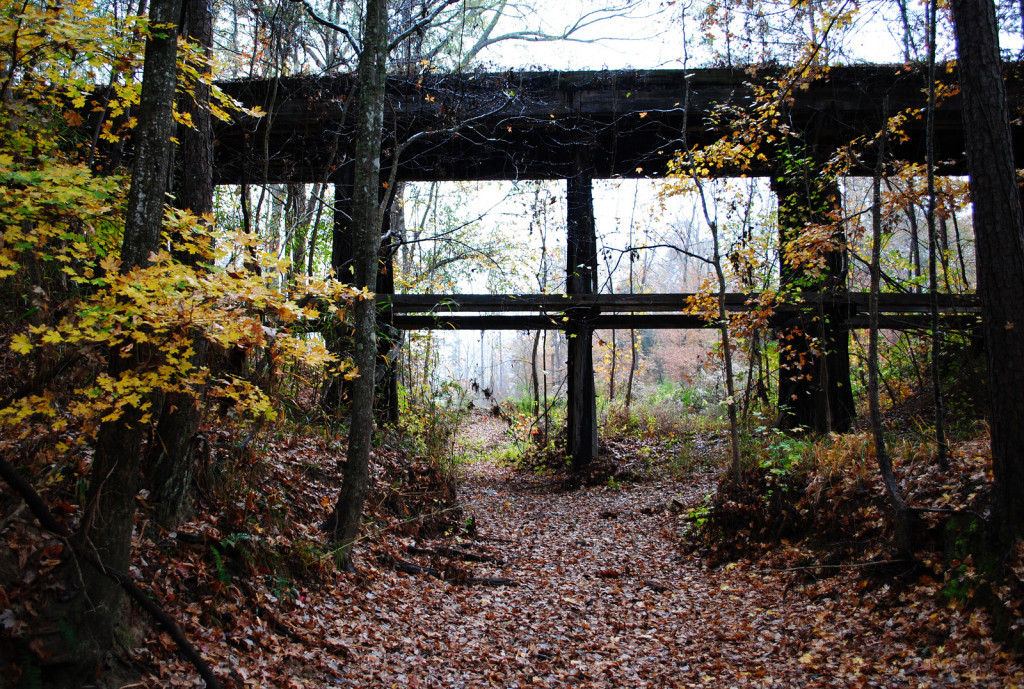
An abandoned railway trestle in Zavalla. Photo © Patrick Feller, licensed Creative Commons Attribution.
The Piney Woods are the natural heart of East Texas. Comprised of several national forests and not much else, most of this vast area remains as it has for centuries, when Native American tribes and pioneers hunted wild game in the dense woods by day and slept under the canopy of pine boughs by night. Texans accustomed to their state’s hot summers and unpredictable winters will frequent the recreation areas throughout the year, while out-of-staters prefer to enjoy them during the temperate months of spring and late fall.The moniker “Piney Woods,” a Texas colloquialism, is an endearing term describing this forested region, an image many visitors don’t associate with the stereotypical desert landscape of the Lone Star State. Regardless, these aren’t dense, lush, groves of evergreens— they’re mainly shortleaf and loblolly pines, sprinkled liberally with hardwoods such as oak, elm, ash, and maple. The combination is especially appealing in autumn, when, in another unexpected Texas scene, occasional bursts of changing colors offer a scenic outdoor escape.There’s no shortage of recreational activities in this portion of East Texas, particularly in the national and state forests and parks, which annually draw tens of thousands of campers, bikers, hikers, fishers, and boaters to their natural playscapes. Texans accustomed to their state’s hot summers and unpredictable winters will frequent the recreation areas throughout the year, while out-of-staters prefer to enjoy them during the temperate months of spring and late fall.
These wooded areas provided shelter and sustenance for the region’s earliest inhabitants, the Native American tribes that were largely displaced by Westward frontier expansion. The legacy of the Caddo Indians is evident in the rich history of Piney Woods communities like Nacogdoches, and the Alabama-Coushatta tribe remains a vital cultural presence on its reservation in the Big Thicket National Preserve.
The forests also had a significant impact on East Texas’s economy when the lumber industry became a major contributor to the state’s agricultural output in the late 19th and early 20th centuries. Though much of the area was initially overharvested, the industry eventually recovered and remains an essential economical element today. The Piney Woods community of Lufkin contains several cultural attractions related to the area’s timber-oriented past.
From the 1880s until the 1920s, East Texas’s Piney Woods became a lot less piney. And woodsy. During these four decades, the “lumber bonanza” resulted in 18 million acres worth of timber being cut.
Lumber production started out with small owner-operated sawmills and eventually evolved into sophisticated operations that dominated the East Texas economy in the early 1900s. These corporations built their own railroads into the forests and connected their isolated sawmills with major cities and shipping points for their wood products.
One of the more fascinating aspects of this era was the establishment of lumber “company towns.” The men who worked in the sawmills and on the cutting crews were encouraged to remain with a company for the long haul, and one of the main incentives was the promise of caring for their wives and children.
The companies would choose a location on a rail line and construct a makeshift town, complete with all the basic necessities, including homes, schools, churches, stores, and hospitals. The workers were often paid with credits they could use for food, merchandise, and services in the company town facilities.
Sometimes, the towns would pick up and move along with the ever-changing frontier of virgin forest. Homes located in rail cars allowed for easy mobility, leaving behind a ghost town of clapboard buildings and dirt roads.
By the 1920s, the depletion of the East Texas timber resources combined with the effect of the Great Depression caused the decline of the lumber bonanza. Some of the companies went into bankruptcy, while several of the larger timber corporations moved to the fertile forests of the Pacific Northwest.
Excerpted from the Seventh Edition of Moon Texas.